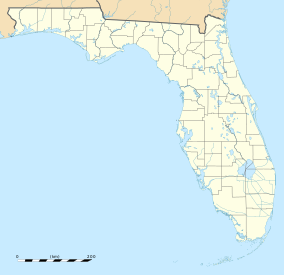Mound Key
| Mound Key Archaeological State Park / Mound Key Site | |
|---|---|
|
IUCN category V (protected landscape/seascape)
|
|
| Location | Lee County, Florida, USA |
| Nearest city | Fort Myers Beach, Florida |
| Coordinates | 26°25′20″N 81°51′55″W / 26.42222°N 81.86528°WCoordinates: 26°25′20″N 81°51′55″W / 26.42222°N 81.86528°W |
| Area | 113 acres (0.46 km2) |
| Established | August 12, 1970 |
| Governing body | Florida Department of Environmental Protection |
Mound Key Archaeological State Park is a Florida State Park, located in Estero Bay, near the mouth of the Estero River. One hundred and thirteen of the island's one hundred and twenty-five acres are managed by the park system. It is a complex of mounds and accumulated shell, fish bone, and pottery middens that rises more than 30 feet above the waters of the bay.
Mound Key was an important site of the Calusa tribe, and most experts believe it to be the site of their capital, Calos. The Mound Key Site on the island was added to the U.S. National Register of Historic Places on August 12, 1970. The island is only accessible by boat from the Koreshan State Historic Site or Lovers Key State Park.
Mound Key was created over 2,000 years ago by the Calusa. The Calusa culture is carbon-dated back to 1150 B.C. at Mound Key. The site likely began as a low-lying oyster bar on Estero Bay. The site would have been rich in marine food resources, and very appealing to the Calusa, who were actually hunter-gatherers. As the human population grew, food waste was heaped into the middens that form the island. The Calusa formed an extensive structure of mounds, water courts and canals whose features still exist today. Mounds were constructed by the collection and organization of “midden” which is a collaboration of shells, fish and animal bone, and artifacts such as pottery. Islands that were created by the Calusa, such as Mound Key are sometimes called “trash-heaps” as their composition is made from waste products of their culture. They are not however, just “heaps of Calusa garbage” simply tossed aside, but intricate compositions of substrate that were used for a display of power, religious monuments, and as burial memorials.It served for many years as the ceremonial center for their kingdom, which extended over numerous shell midden islands they made up and down the southwest coast of Florida. It is also believed by most researchers to have been the site of Calos, the capital of their kingdom. Their kingdom spanned from Tampa Bay southward to the Ten Thousand Islands and eastward to Lake Okeechobee.
...
Wikipedia

